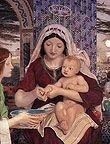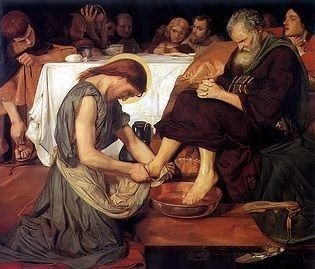|
FORD MADOX BROWN | |||||
Ford Madox Brown painting gallery of royalty free images art works in high resolution. Art and Artist study of his biblical paintings. Always Royalty Free |
Looking at it as they did, Madox Brown perceived that nature was far brighter than it appeared to be in the pictures of his British contemporaries. Since the time of Reynolds, Sir George Beaumont's dictum that a good picture must be a brown picture had been the general opinion, and no English figure painters made any serious stand against it till Ford Madox Brown and the Pre-Raphaelites began to exhibit. The explanation of this brown-picture cult is simple. Painters had observed that the pictures by the old masters, such as Rembrandt, Titian and Tintoretto, were usually brown in tone, but this brownness was often due, not only to the pigments originally used by the masters, but also to the grime of centuries, to the "tone of time." Seeking to be praised as "old masters" in their own time, painters used artificial means to make their pictures look brown and give them a Rembrandtesque shadow. Madox Brown reversed the practice by painting his pictures on a white ground, and immediately his color became brighter and truer to Nature. One of his most important works was begun late in 1851 and occupied a good part of the following year, "Christ Washing Peter's Feet". Frederick Shields tells of attending an exhibition of paintings, including many works of the Pre-Raphaelites at Manchester, England in 1857, when "hung at the very roof was a picture of such power that, slighted as it had been by the judges and unobserved by the general public, it held me riveted. Large and simple in the composition of its masses as Giotto – brilliant and forcible, yet true and refined in its color and lighting, and wonderful in its grasp of human character and passion. Permanently confirmed was my first impression that, among all the English pictures of sacred subjects there, it alone was worthy to rank with the great Italians." Apart from the intrinsic merit of the painting, it is of historic interest in that it contains portraits of several members of the Pre-Raphaelites circle. The head of Christ is declared to be a literal transcript of F. G. Stephens. Of the Apostles, omitting Judas, the first on the left is William M. Rossetti, brother of Dante Gabriel Rossetti, the second, Holman Hunt; the fourth, Holman Hunt Sr, the fifth, C. B. Cayley, the sixth, Dante Gabriel Rossetti, and the seventh is believed to be Christina Rossetti, as St. John. Navigation and Searching – Terms of Use |


